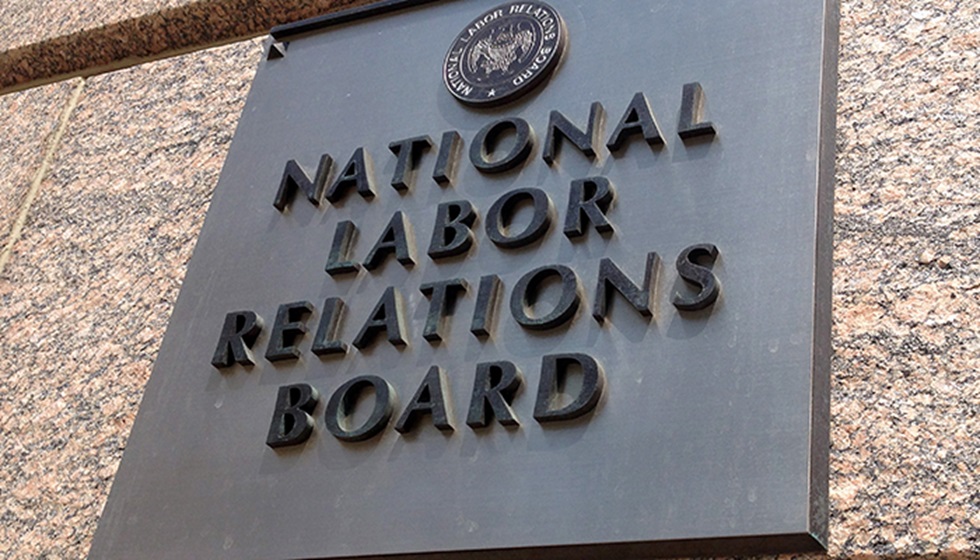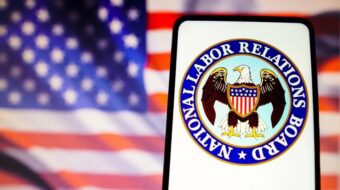
WASHINGTON—The National Labor Relations Board majority has ruled a key tactic which bosses and their union-busters use against union organizing drives, captive audience meetings, is illegal and unconstitutional.
The board’s November 13 ruling follows the lead of eight other states, which now ban bosses from disciplining or firing workers who refuse to attend captive audience meetings. The latest is Alaska.
The others are California, Connecticut, Hawaii, Illinois, Maine, Minnesota, New York, Oregon, and Washington. The Alaskan and Californian bans begin on New Year’s Day. In the same referendum, Alaskans raised the state’s minimum wage to $13 per hour and mandated up to 56 hours of paid sick and family leave per year.
The AFL-CIO cheered the 3-1 ruling, authored by NLRB Chair Lauren McFadden. It helps to balance the scales for workers in organizing drives. The board used a case involving the Amazon Labor Union’s successful drive—despite multiple company captive audience meetings daily—at the firm’s JFK8 warehouse on Staten Island, for its ruling.
Each Amazon captive audience meeting carried the threat of discipline up to and including firing, for workers who resisted. That coercion is illegal and unconstitutional, the board ruled. “At one point in the campaign, the respondent [Amazon] was holding meetings at its JFK8 facility every 45 minutes, six days a week.”
“The NLRB again demonstrated its commitment to working people with the decision to ban captive audience meetings, a coercive tool bosses regularly use to gain an unfair advantage before union elections,” AFL-CIO President Liz Shuler said.
“As part of well-funded and aggressive anti-union campaigns—regularly involving threats of discipline, site closure, wage and job cuts, and threatening immigrant workers with deportation—employers force employees to listen to anti-union speeches, often multiple times, preventing employees from asking questions or even politely leaving the meeting.
“These coercive meetings are well-known union-busting tools, and the practice has no place in America’s workplaces or in our democracy. Thanks to the NLRB, that ends today.
“In siding with Amazon workers, the board has affirmed that captive audience meetings are an affront to worker freedom and that companies will finally be held accountable for this anti-worker behavior.
“Corporations may pour millions in their efforts to union-bust, but the AFL-CIO won’t rest until every worker is free to organize and fight together for a better workplace. We applaud the board and General Counsel Jennifer Abruzzo for their leadership in ending this predatory practice.”
NLRB Chair McFadden cited one of the great Supreme Court justices of all time, Louis D. Brandeis, to rule out the captive audience meetings. Brandeis wrote the constitutional freedom of speech right includes “the right to be let alone.”
“Thus, while the ‘right to persuade’ is an essential right” the Constitution protects, “no one has a right to press even ‘good’ ideas on an unwilling recipient,” the board said.
“Where ‘the degree of captivity makes it impractical for the unwilling viewer or auditor to avoid exposure, the need to protect such unwilling listeners is at its zenith.”
“Captive-audience meetings are now a common feature of campaigns. Given the importance of the issue, we believe a reexamination” of it, which the ruling does at length, “is long overdue.” So is the board’s reversal of its long-standing approval of the captive audience meetings.
“Under the legal status quo, an employer can compel employees, under the threat of discipline or discharge, to attend meetings where they are required to listen to the employer’s views on whether they should unionize or not…An employer can hold these meetings repeatedly, for whatever length of time it wants, and whenever it wants,” except for the 24 hours before a union representation election.’
Bosses can use the meetings to spy on whom workers talk with, their reactions to bosses and union-busters arguments, and “silence or even banish, employees who would express their own views or even just ask questions.
“A captive-audience meeting is an extraordinary exercise and demonstration of employer power over employees in a context” where labor law “envisions employees will be free from such domination. We thus prohibit captive-audience meetings.”
Labor law, backed by the Constitution, says “employers and unions may non-coercively express their views concerning unionization and that the substance” of those views and meetings is protected, too, the majority noted.
We hope you appreciated this article. At People’s World, we believe news and information should be free and accessible to all, but we need your help. Our journalism is free of corporate influence and paywalls because we are totally reader-supported. Only you, our readers and supporters, make this possible. If you enjoy reading People’s World and the stories we bring you, please support our work by donating or becoming a monthly sustainer today. Thank you!










